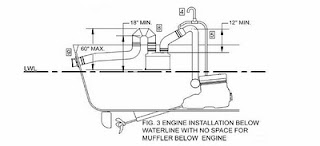

Nothing too scary. Just a little rot from the chain-plates leaks. Git Rot and a coat of West System and some cloth will take care of that. The locker in the lower right of the top photo (most of which is normally obscured by the sink top) looks like a candidate for a water heater. I would install the work surface so that it could be removed/replaced via the heads and not the engine room. The dimensions are 16" Wide, 20" deep and 22"high.
The INDEL MARINE USA, Basic 24 Water Heater, 6.4 gal. Capacity, 19-5/16"L x 15-9/16"dia. seems to be a candidate. It can be mounded vertically on the fuel tank bulkhead.

Or the RARITAN, 1700 Series Water Heater, (6 gal. Heater, Exchanger/120V AC, 14-1/2"dia. x 16-1/4"H )

I am trying not to comment on the individual who put a through hull in the lower right hand locker which could only be serviced by a very skinny person with 5ft long arms.




























